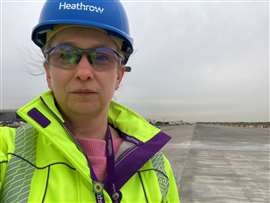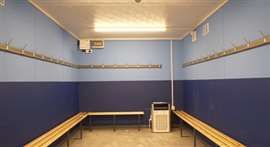Wired differently: Harnessing neurodiverse talent in construction
10 May 2024
With one in four construction workers and nearly half of all construction project managers identifying as neurodiverse, it’s clear that conditions such as autism, dyslexia and ADHD are more prevalent within the industry than in the population at large. Lucy Barnard finds out how construction firms can better accommodate individuals with these conditions - and harness the many skills they bring
Although diagnosed with dyslexia as a child, Jenny McLaughlin, a project manager at Heathrow Airport in the UK, was in her forties when she was told she had attention deficit hyperactivity disorder (ADHD) too.
“It was a complete surprise,” McLaughlin says. “I hadn’t even heard of ADHD when I was growing up. It was only when my son’s school suggested I should get him assessed for the condition that I even thought about it. I went to some support sessions for parents and so much of what they said resonated with me that the facilitator said perhaps you should look into this for yourself.”
For McLaughlin, the diagnosis suddenly made sense of some of the struggles she was facing in her day-to-day working life but also showed her how she was able to use the gifts of neurodiversity to benefit her work.
 Jenny McLaughlin, project manager at Heathrow Airport. Photo: Jenny McLaughlin
Jenny McLaughlin, project manager at Heathrow Airport. Photo: Jenny McLaughlin
“I needed a diagnosis, not because I’m broken by my neurodiversity but because I needed validation,” she says. “I now know that my brain works differently from other peoples’ which means I can make others aware. I can seek to strengthen the areas where I need support, but I can also feel confident sharing my strengths.”
McLaughlin is currently working on project managing the construction of a new National Air Traffic Control contingency control tower at Heathrow Airport into which air traffic control staff could be decanted if the main tower had to be evacuated.
She says, the dual conditions continue to have a significant impact on her day-to-day working life. The dyslexia means it takes her a long time to read through the reports she needs to read, makes the spelling and grammar in emails difficult and gives her poor hand-eye coordination. ADHD on the other hand means she has trouble with her short-term memory and has difficulty focussing on tasks and conversations, especially if there are distractions like background noise.
Nonetheless, McLaughlin says her neurodiversity also comes with positives. It makes her good at connecting with others, able to improvise when things don’t go according to plan, preventing them from spiralling out of control, and good at communicating in a simple style which is easily understood by the many teams she works with.
“I’ve had to learn to be kind to myself and accept my vulnerabilities which I think makes people more comfortable opening up to me. In a project management environment, working effectively with a range of people is a critical part of being able to deliver.”
And, as a neurodiverse project manager in the construction industry, McLaughlin is far from alone.
Why are so many construction workers neurodiverse?
According to a recent survey of 1,000 project managers by the UK-based Association for Project Management (APM), around a third of all respondents considered themselves to be neurodivergent. Moreover, for respondents working in the construction sector, the proportion was even higher, with 46% saying they had a condition such as autism, ADHD and dyslexia.
And it’s not just project managers in the industry who say their brains are wired differently from the norm. A 2003 survey of 1,000 UK-based adults across the construction sector by the National Federation of Builders found that 25% considered themselves to have a neurodiverse condition.
Of those, the most common condition was ADHD which affected 54% while autism came second with 32%. Dyslexia affected 31%, while another 9% said they had attention deficit disorder and 8% said they had dyspraxia. Another 4% said they had dyscalculia.
The figures appear to show a higher prevalence of neurodiversity in the construction industry than in the wider population where estimates for the proportion of people affected stand at around 15-20% (including 10% with dyslexia, 6% with dyspraxia, 5% with ADHD and 1-2% with autism).
“I think quite often the education system tends to encourage children with neurodivergence into practical occupations like construction,” says McLaughlin. “But as a field focussed on practical and visual work it’s not surprising that construction benefits people with neurodiverse conditions who often excel in these areas.”
She points out that although people with these conditions often require some additional support in the workplace, a growing body of evidence shows that they also tend to be blessed with higher-than-average skills in other areas.
ADHD often enables individuals to see the bigger picture, think outside the box and to be effective decision makers.
Autism can bestow individuals with: high levels of technical skills, especially in the fields of software and other tech; an attention to detail that allows them to spot things others may miss; an increased capacity for extended focus; and enable them to memorise facts and reference them easily.
And dyslexics tend to exhibit strong leadership and social influence, exceptional creativity, originality and initiative and be good at complex problem solving, analytical thinking, reasoning and active learning.
Indeed, a growing number of prominent companies, both within the construction sector and outside, have reformed their HR processes in order to better access neurodiverse talent.
Construction firms including Skanska, Eiffage, BAM, Ferrovial and Kier have all set up affinity networks or groups aimed at providing peer support for neurodivergent staff and looking at ways to become more welcoming to new neurodiverse recruits. Innovations include changes to the way candidates are assessed at interview to make them less confrontational to reviewing corporate computer screen backgrounds which were making it difficult for neurodiverse staff to see.
 Balfour Beatty and Sunbelt Rentals EcoSense cabin design with integrated disability and neurodiverse features. Photo: Sunbelt Rentals
Balfour Beatty and Sunbelt Rentals EcoSense cabin design with integrated disability and neurodiverse features. Photo: Sunbelt Rentals
In 2022, UK-based Balfour Beatty, in collaboration with Sunbelt Rentals, rolled out a new type of cabins across its construction sites designed to be more welcoming to differently abled workers. Features include; LED dimmable lights for those hyper sensitive to bright light; acoustic sound barriers; wider corridors for wheelchairs; and coloured plug sockets and switches to assist the visually impaired.
In 2023, Cat Financial, the finance arm of OEM Caterpillar launched a neurodiversity employment programme with autism charity The Precisionists to leverage the talents of a team of neurodiverse adults to provide software testing and perform a variety of other support functions for the company’s IT team.
However, despite these initiatives, much more needs to be done to harness the potential of neurodiverse talent in the construction sector.
According to the US Bureau of Labor Statistics, the employment rate among people with a disability in the USA, both physical and mental, stood at just 22.5%. According to the US-based Stand Together Foundation, 90% of neurodiverse individuals are unemployed, representing the highest rate of unemployment of any group in America. However, neither of these figures takes into account the large number of high performing neurodiverse individuals who have not been diagnosed – or the significant proportion of neurodiverse individuals employed in low skills level roles that doesn’t fully leverage their talent.
How could changing technology benefit neurodiverse workers?
Nonetheless, as technology continues to improve, some experts predict that some of those with neurodiverse brains stand to benefit more than the neurotypical.
A 2019 report by consultancy EY, The Value of Dyslexia: Dyslexic Capability and Organisations of the Future, finds that automation and the widespread adoption of AI is likely to impact the sort of workplace competencies that dyslexics find challenging while their strengths, which tend to be in creative, problem solving and communication skills, will be more in demand.
Back at Heathrow, McLaughlin wants to make it clear that all policies designed to make working life easier and safer for neurodivergent people, eventually make life better for everyone, however their brains are wired.
“The point that I, and I think a lot of neurodiverse people want to make is that all of our brains are wired differently and we should all be given the space and support to understand how our brains work and find the right environment and strategies that work for each one of us,” says McLaughlin. “If we design our workplaces to be more accommodating for those at the fringes then everyone in the centre benefits too so it improves the work environment for everyone.”
|
CONNECT WITH THE TEAM





